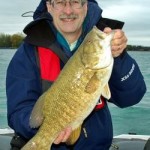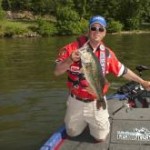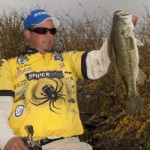Bassmaster Classic BASS Survival Rates
Bass caught in the February 21-23 Bassmasters Classic in north Alabama should survive their moment on stage just fine, says a fishery expert.
By Frank Sargeant, Editor
from The Fishing Wire
A concerned reader inquired last week about the affect hauling Guntersville bass some 80 miles to Birmingham-Jefferson Convention Center for weigh-in at the Bassmaster Classic will have on the survival of the fish. We took the question to Gene Gilliland, the new National Conservation Director for B.A.S.S. and former assistant chief of fisheries for the Oklahoma Department of Wildlife Conservation. Here’s some of what he told us.
“When we had the classic at Grand Lake in Oklahoma last year, we had a very similar situation-the fish were caught some 90 miles from Tulsa and had a 90 minute ride to weigh in and then back. We lost not one fish during that event. I’d like to take all the credit for it, but the biggest factor was very cold weather-the water temperature was in the lower 40’s, and anytime you have that fish can survive a lot of handling without any mortality.”
Gilliland said that based on the weather in North Alabama this year so far, it’s very likely that water temperatures will still be in the 40’s here when the Classic arrives Feb. 21-23.
Bass will be caught at Lake Guntersville, then trailered about 90 minutes to weigh in at the Birmingham Convention Center for a live weigh-in, then returned to the lake for release by the Alabama Department of Conservation and Natural Resources.
He said that the improved livewells in modern bass boats are also a factor in very low mortality rates during pro-level tournaments.
“B.A.S.S. has worked with bass boat companies for years providing oxygen level and temperature data at weigh-ins, and the companies have responded by greatly improving the wells so that the fish can survive; the wells of modern boats hold more water and have bigger fill and aeration pumps, and that really helps the fish stay healthy.”
Gilliland said each competitor is checked when he ramps out to make sure the live well is full, the aerator is working, and that his fish are healthy. (It’s highly important to the anglers that the fish survive for reasons other than conservation-a dead fish at weigh-in means a penalty, and that can cost them a six-figure paycheck in the Classic.)
Another factor is careful handling during the weigh-ins, Gilliland said.
Whether it’s top pro Edwin Evers or some other competitor on top after final weigh-in, the bass will survive to fight another day.
“We use a mesh big inside a vinyl bag. When the fish are set down into the folds of that mesh and the bag is filled with water, it’s like they’re hiding in a weedbed, it has a calming affect on them, and then they’re brought to the scales in under a minute typically. Immediately after the weigh-in they go down through a trapdoor into the large holding tank maintained by the Alabama Department of Conservation and Natural Resources, which is basically a 500-gallon aquarium, and at the end of each day that will be trucked back to the lake.”
Gilliland said the fish are not handled during the release-a large pipe is used to funnel them back into the water. He said they’re typically released in several different locations to avoid “stacking” one spot that can then be harvested by local anglers.
Gilliland said that the impact of the Classic on Guntersville’s bass fishery would be very minimal, in any case.
“We’re only talking about 56 anglers here, while on any given weekend there may be several tournaments on Guntersville that have twice that many boats, each. And, because of the timing of the weigh-in, the Classic pros fish a short day; the bass are in the well no longer than they would be in an event on the lake, where weigh-in might not begin until late afternoon.”
In short, it appears that the impact of angler harvest during the Classic should not be a point of concern for area bass anglers-and those who watch the pro’s carefully just might learn a few honey holes and tactics that can make them more successful on their next trip to fish the lake.



